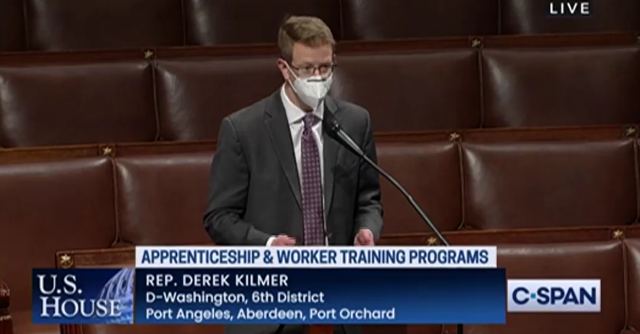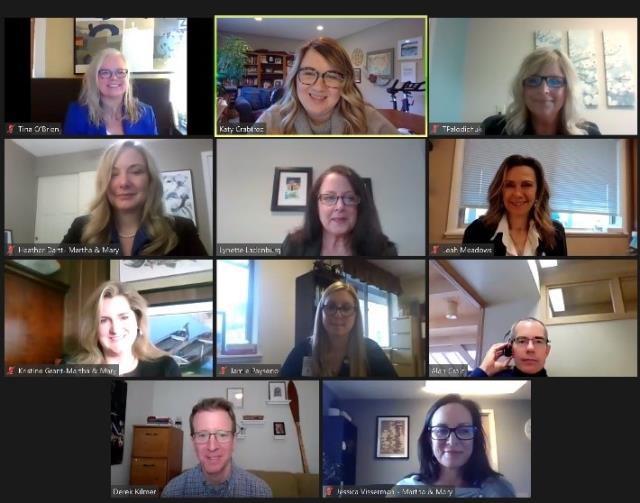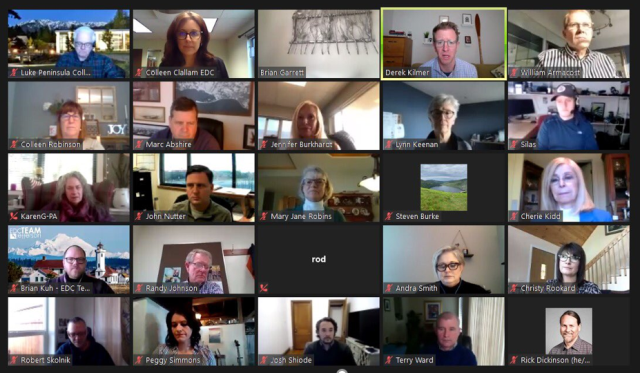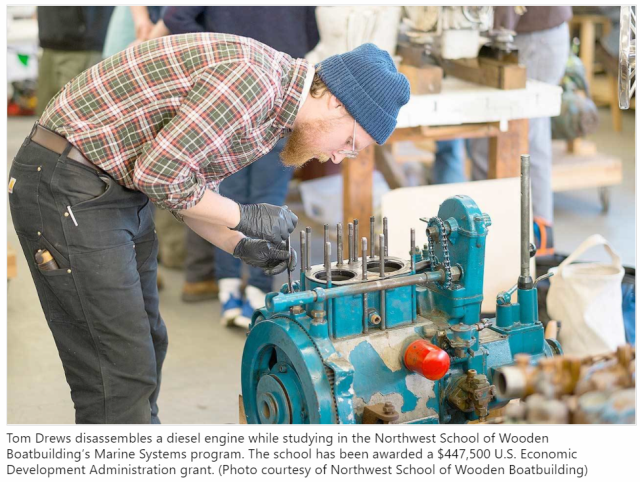Working to Deliver the Relief Needed to Combat this Crisis
Hi Folks –
I hope you all enjoyed Super Bowl Sunday. Honestly, I found the game kind of “meh.” But I had delicious snacks (wings!), enjoyed the commercials (Will Ferrell may be my MVP), and – while I was rooting for Kansas City – was mightily impressed with Tom Brady.
I’ve had a busy few weeks in D.C. as the federal government works to respond to the COVID-19 pandemic. I’ve been pushing to give our communities the resources they need to help beat back this virus and distribute vaccines, provide vital support to families and local employers, and get our economy off the mat. Let’s get right into the details!
Getting More Relief for Our Communities
The COVID-19 pandemic has become the greatest public health crisis of our lifetime and has created the worst economic downturn since the Great Depression. Responding to a challenge of this magnitude requires bold action, and the months-long impasse that we saw in Congress last year was, in my view, recklessly irresponsible.
Over the last year, I have spoken with folks across our region who have lost jobs, lost their small businesses, and lost loved ones due to the COVID-19 pandemic. I’ve heard a lot of pain. People in our region need help. That’s why I’ve been outspoken in pushing Congress to take action.
As you know, President Joe Biden has proposed the American Rescue Plan—an emergency legislative package to fund vaccinations, provide immediate, direct relief to families bearing the weight of the COVID-19 crisis, and support affected communities.
Following the passage of the coronavirus relief package in December, it is clear to me that more help is needed—and it’s clear to experts and economists across the board, too:
- Treasury Secretary Janet Yellen: “Economists don’t always agree, but I think there is a consensus now. Without further action, we risk a longer, more painful recession now – and long-term scarring of the economy later. … Right now, with interest rates at historic lows, the smartest thing we can do is act big. In the long run, the benefits will far outweigh the costs.” (Testimony in her confirmation hearing in the Senate Finance Committee, 1/19/21)
- Mark Zandi, Chief Economist, Moody’s Analytics: “It’s better to err on the side of too much rather than too little. Interest rates are at zero, inflation is low, unemployment is high. You don’t need a textbook to know this is when you push on the fiscal accelerator.” (NYT, 1/30/21)
- According to Moody’s, if the package were enacted in full by March, the analysis projects that GDP would jump by almost 8 percent in 2021 and an additional 4 percent in 2022. At this pace of growth, the economy would create 7.5 million jobs in 2021 (December to December) and an additional 2.5 million jobs in 2022 – resulting in full employment by the fall of 2022 – a full year sooner than without this package. (Moody’s Analytics, 1/15/21)
- Former Top Trump Economic Adviser Kevin Hassett: CNN Business reports, “Former Trump top economic adviser Kevin Hassett broadly supports President Joe Biden’s $1.9 billion rescue package as a way to keep the coronavirus-ravaged economy afloat. … ‘There are so many businesses treading water, barely hanging on. Now they are getting hit by another shock [from the pandemic],’ said Hassett. ‘You could end up in a negative spiral for the economy.’” (CNN Business, 1/22/21)
President Biden’s proposal would expand critical pandemic assistance programs, including a $400 per-week pandemic unemployment insurance supplement, an additional round of direct payments for adults and children, and robust funding for emergency rental, energy, and water assistance to help families that are struggling to make ends meet. The proposal also includes a 15 percent increase in Supplemental Nutrition Assistance Program (SNAP) benefits. Additionally, the plan carves out resources for small businesses and hard-hit industries, including $15 billion in direct grants for more than 1 million of the hardest hit small businesses and $175 billion in loan guarantees to provide additional support to keep small businesses afloat.
I believe that all of these initiatives are important as we work to ensure that people who are hurting can pay their bills, feed their families, and maintain their housing.
In order to continue progress on our national COVID-19 public health response, this plan devotes $20 billion to a national vaccination program—including a targeted effort to distribute vaccines to underserved populations, including communities of color and rural communities, through local and mobile vaccination sites. Additionally, the bill also includes funding to support national testing so that we can get the spread of this virus under control and ease the strain that is acutely felt in our health care system. The bill would also expand the emergency paid leave program to 106 million more Americans. These steps all make sense to me as a means of beating back this virus.
I’m committed to working with the Biden Administration in order to ensure that people who need help get the help that they need.
Expanding Access to Vaccines
I’m also committed to ensuring that people can get access to vaccines. That’s why I co-sponsored the Coronavirus Vaccine and Therapeutic Development Act to ensure that our country can mass-produce and administer vaccines quickly and efficiently. The bill would enable investment in manufacturing capacity for COVID-19 vaccines and therapies to ensure that supply can meet demand to prevent and control the spread of COVID-19. I have a sense of urgency about increasing vaccine supply so we can get more shots to more people more quickly.
So far, two drug companies—Moderna and Pfizer—have received emergency use authorization by the Food and Drug Administration (FDA) for their vaccines for the prevention of COVID-19. Following the approval of these vaccines, folks understandably have questions about the distribution of the vaccine, and the importance of ensuring that it reaches those who are at the greatest risk. With that in mind, I’d like to address those concerns directly.
First, I would encourage you to keep up to date on the latest from the Washington State Department of Health (WSDOH) here at this link. In light of initial limited availability, WSDOH has released their vaccine allocation and prioritization plan to prioritize those who are at the greatest risk. These decisions should be made by medical and public health experts—not politicians—and should be grounded in sound science and reasoning—not politics or special interests. Our state’s guidance was developed by WSDOH with the engagement of expert groups and community partners.
Washington state is currently in Phase 1B tier 1 of vaccine distribution. That means the vaccine is available to anyone 65 and older, and all people 50 and older who also live in a multigenerational household. This is in addition to populations eligible during phase 1A including health care workers at high risk for COVID-19 infection, first responders, people who live or work in long-term care facilities, and all other workers in health settings who are at risk of COVID-19.
Furthermore, WSDOH has launched a Phase Finder Tool, where you can determine the phase for which you will be eligible. To use this tool, you can fill out the questionnaire and eligible individuals will receive a confirmation with further instructions to schedule a vaccination appointment. And, if you are not yet eligible, you will be able to sign up to get an email or text alert for when you do become eligible.
If you have any further questions regarding Washington’s phases or your eligibility, the Washington State Department of Health has both a phone and email vaccine distribution helpline that you can reach at 1-800-525-0127 or COVID.vaccine@doh.wa.gov.
Investing in the Workforce of Tomorrow
When we think about rebuilding our economy, one of the key steps will be ensuring access to good, skilled workers. We know that apprenticeship programs are one of the most effective paths to high quality, work-based learning in America. And, in today’s changing economy, it’s important to continue to find ways to prepare our kids for the jobs of the future.
That’s why last week, the House passed a comprehensive bill to invest broadly in apprenticeship programs across the board, investing more than $3.5 billion over 5 years in expanding opportunities and access to Registered Apprenticeships, youth apprenticeships, and pre-apprenticeships.
According to the U.S. Department of Labor, 94 percent of people who complete Registered Apprenticeships are employed upon completion, earning an average starting wage of above $70,000 annually. Yet, too few Americans have completed an apprenticeship. During a time of record unemployment, the National Apprenticeships Acts of 2021 would mark the first time the National Apprenticeship system has been comprehensively updated since 1937.
I’m proud that this bill included my bipartisan amendment to ensure computer science youth apprenticeship, pre-apprenticeship, and apprenticeship programs are included among the priorities. Not everyone is going to have a tech-related job in the future, but there is a growing demand—a demand that we are struggling to meet—for students able to fill in-demand jobs, and for equipping workers with advanced computer science skills. That’s why my amendment aims to grow the number of computer science programs for students in high school and help prepare them to be successful in the workforce.
These investments will provide more 21st century job opportunities for our kids, more qualified employees for our local employers, and more economic resiliency for our communities. I spoke on the House floor this week about why this is so important:
 |
The National Apprenticeships Act of 2021 passed the House with strong support of Democrats and Republicans. I’m hopeful that the Senate will pass it in the coming weeks so we can help revitalize our economy. A few months ago, Jerome Powell, the Chairman of the Federal Reserve, said that one of the most significant threats to our economy due to the pandemic is the erosion of skills. Investing in the skills of people – young and old – is a vital strategy for strengthening our economy.
Expanding Hands-On Training Programs in Our Region
Speaking of skills... Last week, I was thrilled to announce that the Northwest School of Wooden Boatbuilding was successfully awarded a U.S. Economic Development Administration Public Works and Economic Adjustment grant to help the school address critical shortages of marine technicians by developing an accredited hands-on training program to teaching marine systems. Training will include a focus on electrical, corrosion, plumbing, diesel and outboard engines, heating and cooling, hydraulics and steering, and propulsion.
By investing in this project, the federal government will help provide the equipment needed to train workers and meet the need for experienced maritime technicians in the community. I’m confident that this partnership and collaboration will help create higher-paying jobs, attract private investment, and advance economic resiliency throughout the region. I’m thrilled to support NWSWB!
|
|
Working for You
Supporting Senior Living Centers
We've got to ensure that senior living communities, nursing homes, and aging services have the resources they need to keep seniors and employees safe. It was great to hear from the team at Martha and Mary in Poulsbo to talk about what's needed in the days and weeks ahead. I’ll continue to go to bat for our senior living communities to make sure they have the resources needed to keep folks safe, provide quality care, and weather the storm of this pandemic.
 |
Hearing from Our Local Employers
Over the past year, small businesses in Clallam County have seen their world turned upside down as a result of this pandemic. Thankfully, the team at the Clallam County Economic Development Council has been working fulltime to ensure folks have access to accurate information and vital resources to weather this storm. It was great to be able to have a chance to chat with their members about how to grow good jobs and economic opportunity for folks on the Olympic Peninsula.
 |
OK – that’s it for now, folks! As always, I’m honored to represent you.
Sincerely,
Derek



